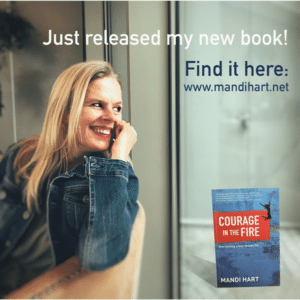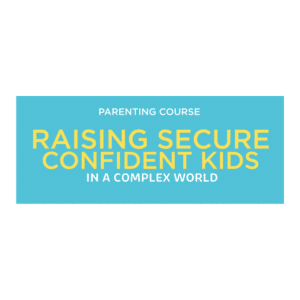Mandi Hart's Blog, page 2
July 26, 2021
How to disciple your children

Parenting takes timeParenting is a journey. It’s not a project and raising children is a long-term commitment, not a one-time event.
Have you thought about your son or daughter’s journey into adulthood? Who do you dream of them becoming? What kind of man or woman? When we disciple our children, we think about these things, and we pray about them. In my book, Parenting with Courage, I wrote: “If parenting were an adventure sport, it would be the most courageous sport in the world. It involves venturing into the unknown, full of unexpected twists and turns, and is completely unpredictable. It is also thrilling and rewarding. Parenting is, by far, my boldest adventure.”
Life-on-lifeBeing a mom or dad is not something you do so much as who you are. You are shaping a life and leaving a legacy. To me, parenting is synonymous with discipleship. Discipleship is a relationship that you walk with someone. It’s a road to travel together, and it takes time. So what does a parenting discipleship journey look like?
If we look at the life of Jesus, we see He walked, talked, and lived with His disciples. He saw the good, the bad, and the ugly. He encouraged, rebuked, taught, loved, and had some fun with his friends. That’s what parenting is like, life-on-life. Now I know that this seems obvious, but I’m emphasizing it to make my point. As you raise your children, you do life with them. They see you at your best and your worst. They learn what life looks like through your lens, and you disciple them. If we don’t teach our children to follow Christ, the world will teach them not to.
Every interaction with your child is an opportunity for discipleship.“God has entrusted us with his most precious treasure – people. He asks us to shepherd and mold them into strong disciples, with brave faith and good character.”
John Ortberg.
A disciple is simply a ‘learner.’ Your children learn from you, and as you instruct them in the ways of growing up, they continue to absorb more of who you are than rather what you are. So be the kind of adult you want your children to grow up into being.
A deeper perspectiveTo mould our children’s character means that we disciple and we discipline. These two concepts are linked. Let me explain: Our English word disciple comes from the Latin word discipulus. The Latin word, disciplina, is also derived from discipulus. Disciplina means teaching and instruction – this is where we get our word, discipline from. Therefore, discipline is linked to discipleship. God’s wisdom is such that parents lovingly disciple their children with instruction and teaching, For a deeper insight, I encourage you to read Hebrews 12:1-11.
How do you disciple your children?Here are a few tools for discipling your children. This is for you and me. As parents, we are our children’s primary instructors in following Jesus. We model a lifestyle of love and obedience to His commands and how to cultivate a relationship with God. Schools and churches are poor substitutes for parents who are mandated by the Lord to teach their children His ways.
Our mandate is clear in Deuteronomy 6:5-7 NLT: “And you must love the Lord your God with all your heart, all your soul, and all your strength. And you must commit yourselves wholeheartedly to these commands that I am giving you today. Repeat them again and again to your children. Talk about them when you are at home and when you are on the road, when you are going to bed and when you are getting up.”
This is our charge.This is our call.“Train up a child in the way he should go – but be sure you go that way yourself,” wrote Charles Spurgeon.
We show our love to the Lord by discipling our children and teaching them to love Him and obey His voice. It means that we parent intentionally. We prayerfully consider all the aspects of our children’s lives, from schooling to friends, to physical development, to purity, to their emotional growth and everything in between.
Parenting is a 24/7 call.Below are two examples of discipling your children.
The first one is called a Shema statement.
The Shema statement means “Listen up” and is used to show that God is active. He is interested in our lives. He speaks to us. This is a simple way to remind us that God is everywhere and is in everything. And it helps create a Biblical worldview. An example of a Shema statement is: “Isn’t today lovely? God has created the mountains and the trees, and they are wonderful.”
A second way is to have regular family devotions with your children.
Teach them how to hear God’s voice and when they do, write it down and help them act on it. When our children are young, we externally model our values. During their teen years, they will begin to accept and adopt the values for themselves or reject them. During their formative years, you can teach them to love God’s word, to hear and obey His voice, and to cultivate a thankful heart. A grateful heart opens the door to praise and worship.
During family devotions be sure to:
Teach them how to be thankful.Show them how to give and receive forgiveness.When you read a passage, ask them this question: What does this tell me about God, and what does tell me about humans?Help them to hear God’s voice and listen to Him and to obey.Ask them regularly: “what is God speaking to you about?”Pray with themMake sure the devotions are fun and relevant to their particular age.Discipleship is loveLove’s face has many forms. For our children, it is safety, a smile, a tender hug, discipline, teaching, time spent with them, and it is pointing them to Jesus. What greater gift could we give them than a love for God and opening the way for them to encounter the One who gave Himself for them? Love your children well and into the Kingdom of heaven.
The happiest of children are those whose mothers and fathers succeed in winning their tender hearts and affection. They will come to understand the love and mystery of God. To disciple your children is truly a long obedience in the same direction. And the direction is into knowing they are loved by God and love Him in return.
The post How to disciple your children appeared first on Mandi Hart.
July 2, 2021
Practical tips for children, teens and adults with too much energy
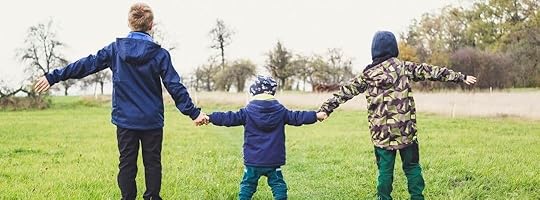
As a human, we are wired to move. Movement is in our DNA. But what can we do to release all that excess energy?
Children seem to be born with endless energy. I remember when my children were toddlers. I often wondered where it all came from – and struggled to keep up with them at times.
Boundless energy, the insatiable need for learning and movement coupled with tired or overwhelmed parents, can become a recipe for disaster in the home.
In South Africa, our children all went on an early holiday because of Covid-19 lockdown. It was a sudden movement and left many families scrambling for a strategy.
Here are a few positive ideas to encourage a healthy release of energy. I’m going to break it down into young children, teens and then for you, the parent.
When we encourage our children to play, then learning and growth happen. I love this quote by O Fred Donaldson: “Children learn as they play. Most importantly, in play, children learn how to learn. ”
Children need to move“Every day, in a 100 small ways, our children ask, ‘Do you hear me? Do you see me? Do I matter?’ Their behavior often reflects our response.” ~ L.R. Knost
Get them movingKeeping your children inside all day with quieter activities will usually create a build-up of tension in their little bodies. Help keep them (and you calmer) by planning for daily physical activities. I remember taking my youngsters for walks, bike rides, and even races around the garden. I used to create a mini obstacle course for them in our garden. If space is limited consider dancing around to a fun song. It will be good for you as well.
Use what’s in natureWhen your children play in nature, it not only aids learning but helps them relax as well. Don’t be scared of a little rain. When it’s raining, put on gumboots and a raincoat and go splash in puddles. Or make mud pies and go pick some flowers on a walk.
Think about their sensesSensory play is a positive and helpful experience for your children. Try making natural playdough with essential oils mixed in. Get them cooking or baking with you. It is messy but builds the connection and memories. To this day, my son speaks about all the cookie building (and dough eating) times we had when he was young. Get creative about stimulating their senses.
Teens thrive on creativity to get them movingAlthough teens might look like they want to sleep or be in their rooms all the time, getting them outside and helping them process their excess energy is a win for all.
Covid-19 has produced an increase in anxiety in teens as never before. With so much uncertainty, many don’t know how to handle the changes in schooling, lack of sport or natural life rhythms. You can help this by encouraging regular movement.
Healthy peer pressureTalk to your teens about different activities their friends are doing? For example, tennis games, going to the golf driving range or learning a new sport with their friends. Use healthy peer pressure to your advantage.
Family connectionEven though they might look as if they don’t want to be around you, they really do need you more than ever.
Creatively encourage family connection by going for a walk together or setting up an exercise routine that you all do at your own pace throughout the day. Educate them about the benefits of healthy exercise as you work at building resilience in their lives. Teens need 1 hour or more of moderate to strong physical activity daily. It’s so very necessary to their growth and well-being.
Give them control over how they moveIn an article on Kid’sHealth, the writer expresses that parents should give teens control over how they decide to be physically active. Teens want to make their own decisions, so give them a choice. Emphasize that it’s not what they do — they just need to be active.
Once they get started, many teens enjoy the feelings of well-being, reduced stress, and increased strength and energy they get from exercise. As a result, some begin to exercise regularly without nudging from a parent.
Make it an easy win for your teen. For example, buy a skipping rope or help them get what they need to get moving. Celebrate exercise wins in the home. I’ve realized that as my children grew into teens, that when they exercise regularly, their mood improves and their ability to concentrate grows.
“The word ‘education’ comes from the Latin ‘educere’ = e- (out of) + -ducere (to draw). Education is not just about putting information in. We have forgotten that it, in fact, begins in the child’s heart.” ~ Vince Gowmon
“A child must know that he is a miracle, that since the beginning of the world there hasn’t been, and until the end of the world there will not be, another child like him.” ~ Pablo Casals
“If children feel safe, they can take risks, ask questions, make mistakes, learn to trust, share their feelings, and grow.” ~ Alfie Kohn
Adults need to get rid of their excess energy tooToo much stress, anxiety and a build-up of feeling overwhelmed are not good. Right, we know that. But what can we do about it?
Sometimes we don’t even realize we have too much energy because we feel tired. Here are a few practical tips for parents. Remember you are your child’s first role model.
Plan some exercise into your daily routine.Just as you would plan a meeting in your diary, schedule exercise into your routine. I read a saying a while ago that said, “For health and wellbeing sit in the sun for 30 minutes, in times of stress, sit in the sun for an hour.” In times of stress, one of the first things to fly out of the window is our exercise routine, yet it is the very thing we need.
Figure out what you enjoyWhen movement is enjoyable, we are likely to do it more often. One day, I returned home from a 25k trail run and hike. My mom remarked how alive my eyes looked. I was really tired from the day out but felt alive.
Be aware of your body and sensesSmell the surrounding smells, look around you, listen to the birds. In other words, be fully present. Pack your phone away but be here, right now.
Dance like no one is watchingBelt out your favourite tune, put the music on loud and dance as you used to as a child. Did you know that dancing develops muscles, tones your body, improves your posture, balance, coordination and promotes greater flexibility. Plus, you’ll find that you will probably end of laughing or smiling and that’s such a good thing too.
Laugh till your belly achesA good laugh doesn’t just lighten your load mentally, it enhances your intake of oxygen-rich air and increases the endorphins that are released by your brain. Laughter can stimulate circulation and aid muscle relaxation. What a great energy release!
Now, when you feel like there is too much energy in your home, pick one of these options and get moving. It will do you all the world of good!
The post Practical tips for children, teens and adults with too much energy appeared first on Mandi Hart.
June 22, 2021
Cure for the drought of love & kindness in Covid-19

Well, are we there yet?It seems as if the lockdown life is never-ending. Although mentally, I know that this season will pass, it just seems to keep going on and on, much like a long road trip. You know the part. The one in the middle, where you’re neither here nor there and it is straight for miles and miles. The kids sound like a stuck record, “Are we there yet?”
What’s the cure for this liminal space that we find ourselves in? Every Monday I speak on the radio about Courageous Parenting & Living. During one of our conversations, it emerged that there seems to be a drought in people’s hearts of love and kindness.
We need more love and kindnessA lack of love and kindness has many side effects, similar to that of a physical drought. Our hearts begin to dry up and crack. We feel brittle, as if, something will cause us to crack and break. Our capacity for growth is limited. And perhaps we feel as if we are shrinking inside. It’s hard to reach out to others when you don’t have much left inside of you.
Covid-19 has left us with more than an uncertainty and fear of contamination.
In an article on forbes.com, the writer, Alice Walton, expresses her thoughts, “The pandemic has contributed to a rise in depression, anxiety, and suicidal thoughts over the last 15 months: physical and social isolation, loss of work, fear of contracting or spreading the virus, and loss of loved ones have been hard to cope with, to say the least.”
“The reality is that mental health is strongly dependent on what’s going on in world, as well as our personal commitments and constraints—financial, familial, social, and so on.”
How does all of this contribute towards drought in people’s lives?
Well, life is more challenging than before. But, there is light and there is hope.
VUCA shows us what we’re facingMany years ago, the military coined a term to help their soldiers understand the world around them: VUCA
A VUCA world is where we are now. Let me unpack it for you.
V stands for Volatile.And, boy are things volatile right now. I’d like to present that we combat that volatility with peace in our lives. Starting with ourselves and moving in ever-widening circles. John 14:27 encourages with these words, “Peace I leave with you; my peace I give to you. Not as the world gives do I give to you. Let not your hearts be troubled, neither let them be afraid.”
U stands for UncertainJust look at the news, at the symptoms of Covid-19 and the levels of uncertainty rises. To water the drought in our hearts, we can move towards surrender. Often, change comes around the corner from surrender. Fear will try and stop you, my friend. But, don’t let it in. One thing I do know is that God does not want you live in fear. Fear robs you of your peace, your joy and capacity. It’s like the scorching sun on an already dry heart. Surrender that which you cannot control. When we lay down our feelings of uncertainty, we can return to a place of simple faith and trust. Trust in Lord with all your heart, it’s water for your soul.
C stands for ComplexityComplexity is certainly here. There are so many things to consider in this pandemic and one can feel overwhelmed by it all. How about we return to simplicity? Simplicity involves making things easier for us to understand and do. What can you simplify in your life? What do you need to say ‘no’ to, so that you can live with greater margin and joy? Choose the better as you go about your day? If your heart is feeling dry, consider what type of rain do you need in your life? Gentle soaking or a huge downpour? Then, position yourself to receive. And that might mean decluttering your mind, or even your home. Return to rest and simplicity to combat complexity.
A stands for AmbiguousHow much around you is unclear or undecided? When I read the news, or look at global trends I see ambiguity at work. It seems as if everything open to more than one interpretation; not having one obvious meaning. This can contribute to feelings of insecurity or even a lack of compassion. Kindness can fight that. Look for the truth in the situation you are facing. Let truth lead your emotions and kindness be the strength in your legs.
Water for souls comes in various forms. Sow seeds of kindness and drops of love. Growth happens almost unseen. But wait…soon you will see shoots of hope, joy and courage.
Courage to open your heart to live fully alive.Finally, be the one who breaks the drought of love and kindness in your world. Don’t give in to fear or the lie that things can’t change. Be the one who waters the relationships around you. This world needs you. And you are a world changer in the making
I’d love to hear your thoughts. Please consider leaving a comment so we can all learn together.
The post Cure for the drought of love & kindness in Covid-19 appeared first on Mandi Hart.
June 15, 2021
Stress & fear can hinder your life
Stress and fear are a formidable combination that can rob you of living life to the full. A French writer from the 1600s, Francois de La Rochefoucauld said that we promise according to our hopes and perform according to our fears.
I think that there is an element of truth to that statement. How often do we dream of starting that new business or pursuing a dream that we’ve carried, only to fall short of actually going for it? Our fears limit us in so many ways.
Don’t let fear get you downFear can tire you out and get down. I’ve spoken on this topic for a while now and recently saw first-hand how fear is wreaking havoc in people’s lives. I toured South Africa to share on overcoming fear, to live fully alive. Countless conversations later, one thing is certain. Fear is here to restrict, isolate, and lie to us. A lady came forward after my talk recently, telling me how she was so scared to drive in a car. She had to pep-talk herself to getting into a vehicle so she could come to the event. Sharing on fear of rejection and failure yielded nods from the audience.
Fear produces a stress response in our bodiesAnd now, at the time of Covid-19, fear is having a field day all over the world. Did you know that fear produces a stress response in your body?
Now, I’m not talking about the stress response that propels you into action, such as running away from danger. But, rather the fear response that can hurt us in the long run.
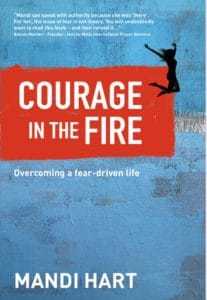 In Courage in the Fire, I explore this effect. Fear prepares us to react to danger. Once we sense we are in potential danger or threat, our body gets ready for fight-or-flight. Facing the effects of fear regularly can cause your body to release hormones such as adrenaline or noradrenaline. The energy generated by these triggers needs to go somewhere.
In Courage in the Fire, I explore this effect. Fear prepares us to react to danger. Once we sense we are in potential danger or threat, our body gets ready for fight-or-flight. Facing the effects of fear regularly can cause your body to release hormones such as adrenaline or noradrenaline. The energy generated by these triggers needs to go somewhere.
If it doesn’t get discharged through fight-or-flight, it can result in chronic stress problems, digestive problems, increased heart disease or other adverse health implications. Fear and stress are a deadly combination – be ruthless in getting rid of them and learn how to deal with the effects of stress well.
Everything is linkedToo much fear converts to stress and anxiety, making our lives more complicated than they should be. The cause and effect produce a plethora of health issues that cost significant time and money to overcome. Fear of any kind and at any level produces stress responses in our bodies. Stress is your body’s way of protecting you from any demand or threat, be it real or imagined.
What causes stress in our bodies?Two factors cause stress in our bodies. Any form of physical exertion is the first factor. And the second is not always easy to recognize because it is the stress our bodies experience due to fear. Because fear is the feeling of agitation and anxiety caused by the presence of imminent danger or a reason for dread or apprehension, stress is present. The brain cannot distinguish between real or imagined threats, but the effect in your body is real. The ability to think, feel and act is all affected because, when you experience fear, you automatically focus on avoiding the threat.
Fear can present itself in our lives in differing degrees – from mild fear such as nervousness or apprehension to more moderate encounters which manifest in agitation, worry or anxiety. For example, I know of a woman who becomes hysterical at the mere mention of a snake. She struggles with ophidiophobia, an abnormal fear of snakes. A lady phoned me one day while I was on the radio, saying that she is afraid of driving in a car. She stays at home because of the anxiety this fear produces.
“Fear always produces an associated stress (emergency) response. The degree of stress response is directly proportional to the degree of fear. The greater the fear, the more dramatic the stress response,” writes Jim Folk, President of anxiety.com.
Folk explains that a stress response will fire every time we experience fear. “Each fear message produces an associated stress response. Even though we may not feel the effects of a stress response reaction, one still occurs. The body always produces an associated stress response to each fear and one that is directly proportional to the level of fear. We don’t escape this reaction.”
How does it affect your life?

Talking to one of my friends about fear, she explained her inner conflict with these words: “Fear was the doorkeeper of my heart, as I was raised being fearful. When fearful thoughts came into my mind, then my imagination would take over with even worse thoughts. Without realizing it, fear took control of my life. I started to live it out by being anxious or fearful in my responses and in the choices that I made.”
Any fear, at any level, will produce a stress response (flight-or-fight) in our body. The degree we experience the fear is directly proportional to the effect on our bodies.
So, what can we do about it, especially in Covid times?Recognize the fears that affect your life? Name them.
Come up with a plan to deal with those fears. What are your options? Perhaps make a list and then take it from there.
Build resilience and capacity in your life. You can do that by improving the quality of your sleep, up your exercise regime and monitor the self-talk going on in your head.
Then, start with small steps towards victory. It’s kind of like climbing a ladder. Take it one step at a time.
Let’s promise and live according to our hopes and not our fears.
 Are you looking for a way to walk fully free from fear?
Are you looking for a way to walk fully free from fear?
Contact Mandi about the options available to you. She invites you into living free from fear and fully alive.
Search for: Follow .et_monarch .et_social_shortcode_0 li,.et_monarch .et_social_shortcode_0.et_social_circle ul li i.et_social_icon { background: #7a9d96; } .et_monarch .et_social_shortcode_0.et_social_rounded .et_social_icons_container li:hover, .et_monarch .et_social_shortcode_0.et_social_rectangle .et_social_icons_container li:hover, .et_monarch .et_social_shortcode_0.et_social_circle .et_social_icons_container li:hover i.et_social_icon { background: #dcae1d !important; } .et_monarch .et_social_shortcode_0 .et_social_icon, .et_monarch .et_social_shortcode_0 .et_social_networks .et_social_network_label, .et_monarch .et_social_shortcode_0 .et_social_networkname, .et_monarch .et_social_shortcode_0 .et_social_count { color: #ffffff !important; } .et_monarch .et_social_shortcode_0 .et_social_icons_container li:hover .et_social_icon, .et_monarch .et_social_shortcode_0 .et_social_networks .et_social_icons_container li:hover .et_social_network_label, .et_monarch .et_social_shortcode_0 .et_social_icons_container li:hover .et_social_networkname, .et_monarch .et_social_rounded.et_social_shortcode_0 .et_social_icons_container li:hover .et_social_count, .et_monarch .et_social_rectangle.et_social_shortcode_0 .et_social_icons_container li:hover .et_social_count { color: #ffffff !important; } List of blogs Stress & fear can hinder your life Teen’s dream comes true with a book deal Bullying and what to do about it 4 ways to grow curiosity in your life What is fear? 6 parenting skills that can make you more productive at work How to return to activity post Covid-19 Don’t panic, you can conquer fear and Covid-19 Advent in an unprecedented season Fear & anxiety affecting the lives of those you love? How to get your matriculant safely through the exams Healthy habits and how to develop them Ditch mom-guilt today A VUCA world and parenting, what a combo! Intentional parents use these five techniques How to fight compassion fatigue in the time of Covid-19 Five ways to stay the ’emotional tsunami’ from Covid-19. Top 30 ways to keep fit, focused and fearless Courage to dream again is possible. Talking about racial injustice with your children Categories Courses FearLess Guest Post Parenting with Courage
Follow .et_monarch .et_social_shortcode_0 li,.et_monarch .et_social_shortcode_0.et_social_circle ul li i.et_social_icon { background: #7a9d96; } .et_monarch .et_social_shortcode_0.et_social_rounded .et_social_icons_container li:hover, .et_monarch .et_social_shortcode_0.et_social_rectangle .et_social_icons_container li:hover, .et_monarch .et_social_shortcode_0.et_social_circle .et_social_icons_container li:hover i.et_social_icon { background: #dcae1d !important; } .et_monarch .et_social_shortcode_0 .et_social_icon, .et_monarch .et_social_shortcode_0 .et_social_networks .et_social_network_label, .et_monarch .et_social_shortcode_0 .et_social_networkname, .et_monarch .et_social_shortcode_0 .et_social_count { color: #ffffff !important; } .et_monarch .et_social_shortcode_0 .et_social_icons_container li:hover .et_social_icon, .et_monarch .et_social_shortcode_0 .et_social_networks .et_social_icons_container li:hover .et_social_network_label, .et_monarch .et_social_shortcode_0 .et_social_icons_container li:hover .et_social_networkname, .et_monarch .et_social_rounded.et_social_shortcode_0 .et_social_icons_container li:hover .et_social_count, .et_monarch .et_social_rectangle.et_social_shortcode_0 .et_social_icons_container li:hover .et_social_count { color: #ffffff !important; } List of blogs Stress & fear can hinder your life Teen’s dream comes true with a book deal Bullying and what to do about it 4 ways to grow curiosity in your life What is fear? 6 parenting skills that can make you more productive at work How to return to activity post Covid-19 Don’t panic, you can conquer fear and Covid-19 Advent in an unprecedented season Fear & anxiety affecting the lives of those you love? How to get your matriculant safely through the exams Healthy habits and how to develop them Ditch mom-guilt today A VUCA world and parenting, what a combo! Intentional parents use these five techniques How to fight compassion fatigue in the time of Covid-19 Five ways to stay the ’emotional tsunami’ from Covid-19. Top 30 ways to keep fit, focused and fearless Courage to dream again is possible. Talking about racial injustice with your children Categories Courses FearLess Guest Post Parenting with Courage The post Stress & fear can hinder your life appeared first on Mandi Hart.
May 8, 2021
Teen’s dream comes true with a book deal
 Emily is gutsy, tender, and super creative. During Covid-19 lockdown, and in her Matric year at Rhenish Girls High School, Emily set about securing a publishing contract for her debut novel, Exposed. Done all on her own, she relentlessly submitted proposals all over the world. Within a couple of weeks, she heard back from Europa Books and set about finalizing the contract and manuscript details. And so, during an unprecedented season of our lifetime, she fulfilled one of her childhood dreams and goals: To be a published author before she turned 18. Now if this isn’t a message to dream big, then I don’t know what is… I got her to answer a few questions for me. Let’s do a deep dive into the mind of a teenager… What was your inspiration for this novel?
Emily is gutsy, tender, and super creative. During Covid-19 lockdown, and in her Matric year at Rhenish Girls High School, Emily set about securing a publishing contract for her debut novel, Exposed. Done all on her own, she relentlessly submitted proposals all over the world. Within a couple of weeks, she heard back from Europa Books and set about finalizing the contract and manuscript details. And so, during an unprecedented season of our lifetime, she fulfilled one of her childhood dreams and goals: To be a published author before she turned 18. Now if this isn’t a message to dream big, then I don’t know what is… I got her to answer a few questions for me. Let’s do a deep dive into the mind of a teenager… What was your inspiration for this novel?Simply my love to write!
Tell us about your dream of becoming a published author?I’ve been writing short stories and coming up with creative plotlines since a young age. When I was in grade six, I wrote down that my dream and goal in life was to be a published author by the end of matric. I’m goal-orientated, so it kept me busy with a purpose and gives me the motivation to keep pursuing my dreams. My parents have always encouraged and supported my goals – they actually pushed me to keep going even when I didn’t think I could, so they really did help me realize my dream.
Give us a glimpse into the book?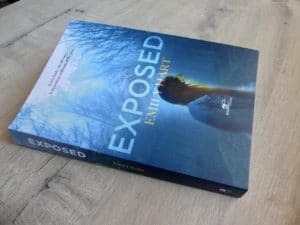 ‘Exposed’ follows the journey of Nate Evans, a detective who just wants more coffee and a holiday. Yet after he is called to solve a case where the only witness is an old close friend, Samantha Grey, he soon finds himself sinking in memories of a past he’s tried hard to bury. As the two of them are forced to put their differences aside to solve the murder, they are led down dark township alleyways, through drug dealer territory, and into the box of a cold case. But that’s only the beginning of the decade of mysteries being unearthed between them…
‘Exposed’ follows the journey of Nate Evans, a detective who just wants more coffee and a holiday. Yet after he is called to solve a case where the only witness is an old close friend, Samantha Grey, he soon finds himself sinking in memories of a past he’s tried hard to bury. As the two of them are forced to put their differences aside to solve the murder, they are led down dark township alleyways, through drug dealer territory, and into the box of a cold case. But that’s only the beginning of the decade of mysteries being unearthed between them…
What message would you give to aspiring teen authors?
Dream big! God knows our dreams, and He goes with us every step of the way, cheering us on.
What was your biggest obstacle in getting this book published?Probably self-doubt. I’ve had so many setbacks, from getting my manuscript stolen on a laptop and wiped, to having major writer’s block. I’ve wondered before if it was possible to reach my goal, but I really do believe that through hard work (and lots of prayer!) and keeping a big picture mindset, anything is possible.
How do you keep yourself motivated?Some days writing feels like the most natural and easy thing in the world when the words just flow and the plot ideas connect together so effortlessly. But other days it’s hard work, and I do it even when I don’t feel like doing it. I’d say about 10% is inspiration, but the other 90% really is just practice, hard work, and keeping the dream alive!
What is your biggest dream at the moment for your future?
I’m currently working on my second novel and it’s a project I’ve been creating for many, many years. It really is something close to my heart and is a story I can’t wait to share with the world. My next dream is to get this one published too and keep going with my writing, my studies, and having a fun first year of varsity!
Where can we find you?My Instagram page is where you can follow me, or else you can email me at [email protected]
Who are your inspirations for writing? And WhyAuthors such as Dee Henderson and Dani Pettrey – they’re authors who really inspire me to keep my writing true to my values and beliefs.
My parents are also a big inspiration for me – they show me what it means to be tenacious and have grit throughout all situations.
Tell the readers something interesting about you…something different?I love to paint, play guitar and passionately tell people about our five chickens.
What are some of your favourite books, movies or quotes?I love the Hunger Games, Divergent, and Maze Runner series, they inspire me to write stories that ask ‘what if’ and use the power of storytelling to challenge society and build bridges between people of all kinds.
Favorite book quote: “If you don’t see the book you want on the shelf, write it.” -Beverly Cleary
Emily’s book is sold in Italy, France, Spain, England, and Germany. If you’re in South Africa and you would like a copy, please order one here (limited stock available)
Search for: Follow .et_monarch .et_social_shortcode_0 li,.et_monarch .et_social_shortcode_0.et_social_circle ul li i.et_social_icon { background: #7a9d96; } .et_monarch .et_social_shortcode_0.et_social_rounded .et_social_icons_container li:hover, .et_monarch .et_social_shortcode_0.et_social_rectangle .et_social_icons_container li:hover, .et_monarch .et_social_shortcode_0.et_social_circle .et_social_icons_container li:hover i.et_social_icon { background: #dcae1d !important; } .et_monarch .et_social_shortcode_0 .et_social_icon, .et_monarch .et_social_shortcode_0 .et_social_networks .et_social_network_label, .et_monarch .et_social_shortcode_0 .et_social_networkname, .et_monarch .et_social_shortcode_0 .et_social_count { color: #ffffff !important; } .et_monarch .et_social_shortcode_0 .et_social_icons_container li:hover .et_social_icon, .et_monarch .et_social_shortcode_0 .et_social_networks .et_social_icons_container li:hover .et_social_network_label, .et_monarch .et_social_shortcode_0 .et_social_icons_container li:hover .et_social_networkname, .et_monarch .et_social_rounded.et_social_shortcode_0 .et_social_icons_container li:hover .et_social_count, .et_monarch .et_social_rectangle.et_social_shortcode_0 .et_social_icons_container li:hover .et_social_count { color: #ffffff !important; } List of blogs Teen’s dream comes true with a book deal Bullying and what to do about it 4 ways to grow curiosity in your life What is fear? 6 parenting skills that can make you more productive at work How to return to activity post Covid-19 Don’t panic, you can conquer fear and Covid-19 Advent in an unprecedented season Fear & anxiety affecting the lives of those you love? How to get your matriculant safely through the exams Healthy habits and how to develop them Ditch mom-guilt today A VUCA world and parenting, what a combo! Intentional parents use these five techniques How to fight compassion fatigue in the time of Covid-19 Five ways to stay the ’emotional tsunami’ from Covid-19. Top 30 ways to keep fit, focused and fearless Courage to dream again is possible. Talking about racial injustice with your children Going back to school? Six essential things to consider. Categories Courses FearLess Guest Post Parenting with Courage
Follow .et_monarch .et_social_shortcode_0 li,.et_monarch .et_social_shortcode_0.et_social_circle ul li i.et_social_icon { background: #7a9d96; } .et_monarch .et_social_shortcode_0.et_social_rounded .et_social_icons_container li:hover, .et_monarch .et_social_shortcode_0.et_social_rectangle .et_social_icons_container li:hover, .et_monarch .et_social_shortcode_0.et_social_circle .et_social_icons_container li:hover i.et_social_icon { background: #dcae1d !important; } .et_monarch .et_social_shortcode_0 .et_social_icon, .et_monarch .et_social_shortcode_0 .et_social_networks .et_social_network_label, .et_monarch .et_social_shortcode_0 .et_social_networkname, .et_monarch .et_social_shortcode_0 .et_social_count { color: #ffffff !important; } .et_monarch .et_social_shortcode_0 .et_social_icons_container li:hover .et_social_icon, .et_monarch .et_social_shortcode_0 .et_social_networks .et_social_icons_container li:hover .et_social_network_label, .et_monarch .et_social_shortcode_0 .et_social_icons_container li:hover .et_social_networkname, .et_monarch .et_social_rounded.et_social_shortcode_0 .et_social_icons_container li:hover .et_social_count, .et_monarch .et_social_rectangle.et_social_shortcode_0 .et_social_icons_container li:hover .et_social_count { color: #ffffff !important; } List of blogs Teen’s dream comes true with a book deal Bullying and what to do about it 4 ways to grow curiosity in your life What is fear? 6 parenting skills that can make you more productive at work How to return to activity post Covid-19 Don’t panic, you can conquer fear and Covid-19 Advent in an unprecedented season Fear & anxiety affecting the lives of those you love? How to get your matriculant safely through the exams Healthy habits and how to develop them Ditch mom-guilt today A VUCA world and parenting, what a combo! Intentional parents use these five techniques How to fight compassion fatigue in the time of Covid-19 Five ways to stay the ’emotional tsunami’ from Covid-19. Top 30 ways to keep fit, focused and fearless Courage to dream again is possible. Talking about racial injustice with your children Going back to school? Six essential things to consider. Categories Courses FearLess Guest Post Parenting with Courage The post Teen’s dream comes true with a book deal appeared first on Mandi Hart.
April 29, 2021
Bullying and what to do about it
A healthy mind doesn’t speak ill of others. Children and adults should live free from bullying and it’s time we all took a stand against it. As Ralph Maccio said, “Bullying happens at all ages and at all levels.”
Bullying hurts everyoneEvery week, Sean Collard and I chat about family-related topics. This week is was around bullying and what a response from our listeners.
One mother shared this tragic story with us. She wrote that they bullied her son in Grade 6. He was very young and then committed suicide over 20 years ago. What a hard message to read.
But, did you know that 1 out of 4 kids is bullied? And that 58% have not told their parents or an adult about something mean or hurtful that happened to them online.
My heart is aching over the pain our children and adults are feeling around bullying. We’ve all experienced it or seen it happen around us. But, we cannot turn a blind eye.
Moms and Dads, get educated. Learn about it so that you can have meaningful conversations with your children. It’s worth the extra effort.
Forms of bullyingDid you know that bullying can take several forms? They include physical bullying such as hitting, punching, kicking or beating. Your child could be subject to verbal teasing, name-calling, or threats or even emotional bullying such as intimidation by others using gestures, social exclusion, or threats. Sexual or racist bullying happens as well as cyberbullying in the form of online harassment, hate messages, threats, impersonation, and other digital abuse.
But what can you do?Firstly, be involved in your children’s world. Know what is going on and pay attention. Read up on this topic.
I read a great article on different types of bullies parents should watch for. Sherri Gordon wrote, “Not all bullies are the same. Each has a different style and uses different tactics to intimidate and control their victims. For instance, some kids that bully are very sly about how they attack their target, while others are downright mean. By being aware of not only the types of bullying but also the types of bullies your child may encounter, you will be better equipped to help your child in any situation.”
Some of the warning signs include: Your child comes home with torn, damaged, or missing pieces of clothing, books, or other belongingsThey have unexplained cuts, bruises, and scratchesAre starting to take drugs or drink alcoholThey seem to be afraid of going to school, taking part in extra-mural activities, or doing things with their peers.Finds or makes up excuses as to why they can’t go to schoolHas lost interest in schoolwork or suddenly begins to do poorly in schoolAppears sad, moody, teary, or depressed when he or she comes homeComplains frequently of headaches, stomachaches or other physical ailmentsHas trouble sleeping or has frequent bad dreams.Experiences a loss of appetiteAppears anxious and suffers from low self-esteemTheir self-confidence takes a dive.What to do if you suspect your child is a victim of bullying
Your child comes home with torn, damaged, or missing pieces of clothing, books, or other belongingsThey have unexplained cuts, bruises, and scratchesAre starting to take drugs or drink alcoholThey seem to be afraid of going to school, taking part in extra-mural activities, or doing things with their peers.Finds or makes up excuses as to why they can’t go to schoolHas lost interest in schoolwork or suddenly begins to do poorly in schoolAppears sad, moody, teary, or depressed when he or she comes homeComplains frequently of headaches, stomachaches or other physical ailmentsHas trouble sleeping or has frequent bad dreams.Experiences a loss of appetiteAppears anxious and suffers from low self-esteemTheir self-confidence takes a dive.What to do if you suspect your child is a victim of bullyingThe above signs are signs of bullying but could also be indicators of other abuse. If your child displays any of these signs talk with them and talk with the school staff to learn more about what’s going on. Don’t remain silent. It takes courage to confront the pain we see not only in ourselves but in others as well.
From parenting experience, sometimes it helps to take a roundabout approach. When talking with your son or daughter, don’t ask straight out immediately if they are being bullied. Try these few approaches to get the conversation going and uncover what’s really going on.
Suggested conversation starters
“I’ve heard a lot about bullying in the news lately. Is that going on at your school?”
“I’m worried about you. Are there any kids at school who may be picking on you or bullying you?”
“Are there any kids at school who tease you in a mean way?”
“Do you have any special friends at school this year? Who are they? Who do you hang out with?”
“Who do you sit with at breaktime? What do you do during breaktime?”
“Are there any kids at school who you really don’t like? Why don’t you like them?”
This is merely a start to open up the conversation. Focus on the Family also have great resources. In one article, the author wrote, “You’re beginning to hear a theme: talk about it with your kids. Whatever the “it” is, talking about it occasionally, frequently, in-depth, or in passing keeps you connected to your children, so find the time and the best way to do so.”
Don’t you think it’s time we choose kindness and stop bullying?
I gathered a few quotes about anti-bullying that can be used as conversation starters in your home. I hope that they will encourage you to take a stand for yourself and help your children do the same.
Here are some for you to think about.“For me, I am driven by two main philosophies: know more today about the world than I knew yesterday and lessen the suffering of others. You’d be surprised how far that gets you.” – Neil deGrasse Tyson
“If you are neutral in situations of injustice, you have chosen the side of the oppressor. If an elephant has its foot on the tail of a mouse, and you say that you are neutral, the mouse will not appreciate your neutrality.”
“No one heals himself by wounding another.”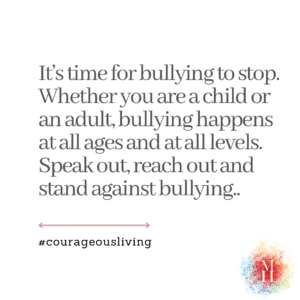
“Bystanders who do nothing give bullies permission inadvertently to go one being bullies. Most are afraid they’ll lose friends or be bullied themselves if they help victims or report bullies, and some feel guilty for years afterward.”
“People say sticks and stones may break your bones, but names can never hurt you, but that’s not true. Words can hurt. They hurt me. Things were said to me that I still haven’t forgotten.” –Demi Lovato
“I got made fun of constantly in high school. That’s what built my character. That’s what makes you who you are. When you get made fun of, when people point out your weakness, that’s just another opportunity for you to rise above.” – Zac Efron
“People who repeatedly attack your confidence and self-esteem are quite aware of your potential, even if you are not.” – Wayne Gerard Trotman
“Bullies don’t like to fight, son. They like to win. Being afraid is normal. The only fight you really have to win is the one against the fear.” – Kwame Alexander
“But to you who are listening I say: Love your enemies, do good to those who hate you, bless those who curse you, pray for those who mistreat you.” Luke 6:27-28
If you have a story to share, I’d love to hear it. Please email me or comment on this blog post.And let’s get the message out there that bullying has to be exposed and stopped, whether it is a child or adult that is facing this challenge. Let’s end bullying around us.
Search for: Follow .et_monarch .et_social_shortcode_0 li,.et_monarch .et_social_shortcode_0.et_social_circle ul li i.et_social_icon { background: #7a9d96; } .et_monarch .et_social_shortcode_0.et_social_rounded .et_social_icons_container li:hover, .et_monarch .et_social_shortcode_0.et_social_rectangle .et_social_icons_container li:hover, .et_monarch .et_social_shortcode_0.et_social_circle .et_social_icons_container li:hover i.et_social_icon { background: #dcae1d !important; } .et_monarch .et_social_shortcode_0 .et_social_icon, .et_monarch .et_social_shortcode_0 .et_social_networks .et_social_network_label, .et_monarch .et_social_shortcode_0 .et_social_networkname, .et_monarch .et_social_shortcode_0 .et_social_count { color: #ffffff !important; } .et_monarch .et_social_shortcode_0 .et_social_icons_container li:hover .et_social_icon, .et_monarch .et_social_shortcode_0 .et_social_networks .et_social_icons_container li:hover .et_social_network_label, .et_monarch .et_social_shortcode_0 .et_social_icons_container li:hover .et_social_networkname, .et_monarch .et_social_rounded.et_social_shortcode_0 .et_social_icons_container li:hover .et_social_count, .et_monarch .et_social_rectangle.et_social_shortcode_0 .et_social_icons_container li:hover .et_social_count { color: #ffffff !important; } List of blogs Bullying and what to do about it 4 ways to grow curiosity in your life What is fear? 6 parenting skills that can make you more productive at work How to return to activity post Covid-19 Don’t panic, you can conquer fear and Covid-19 Advent in an unprecedented season Fear & anxiety affecting the lives of those you love? How to get your matriculant safely through the exams Healthy habits and how to develop them Ditch mom-guilt today A VUCA world and parenting, what a combo! Intentional parents use these five techniques How to fight compassion fatigue in the time of Covid-19 Five ways to stay the ’emotional tsunami’ from Covid-19. Top 30 ways to keep fit, focused and fearless Courage to dream again is possible. Talking about racial injustice with your children Going back to school? Six essential things to consider. Lamenting, an invitation to honesty Categories Courses FearLess Guest Post Parenting with Courage
Follow .et_monarch .et_social_shortcode_0 li,.et_monarch .et_social_shortcode_0.et_social_circle ul li i.et_social_icon { background: #7a9d96; } .et_monarch .et_social_shortcode_0.et_social_rounded .et_social_icons_container li:hover, .et_monarch .et_social_shortcode_0.et_social_rectangle .et_social_icons_container li:hover, .et_monarch .et_social_shortcode_0.et_social_circle .et_social_icons_container li:hover i.et_social_icon { background: #dcae1d !important; } .et_monarch .et_social_shortcode_0 .et_social_icon, .et_monarch .et_social_shortcode_0 .et_social_networks .et_social_network_label, .et_monarch .et_social_shortcode_0 .et_social_networkname, .et_monarch .et_social_shortcode_0 .et_social_count { color: #ffffff !important; } .et_monarch .et_social_shortcode_0 .et_social_icons_container li:hover .et_social_icon, .et_monarch .et_social_shortcode_0 .et_social_networks .et_social_icons_container li:hover .et_social_network_label, .et_monarch .et_social_shortcode_0 .et_social_icons_container li:hover .et_social_networkname, .et_monarch .et_social_rounded.et_social_shortcode_0 .et_social_icons_container li:hover .et_social_count, .et_monarch .et_social_rectangle.et_social_shortcode_0 .et_social_icons_container li:hover .et_social_count { color: #ffffff !important; } List of blogs Bullying and what to do about it 4 ways to grow curiosity in your life What is fear? 6 parenting skills that can make you more productive at work How to return to activity post Covid-19 Don’t panic, you can conquer fear and Covid-19 Advent in an unprecedented season Fear & anxiety affecting the lives of those you love? How to get your matriculant safely through the exams Healthy habits and how to develop them Ditch mom-guilt today A VUCA world and parenting, what a combo! Intentional parents use these five techniques How to fight compassion fatigue in the time of Covid-19 Five ways to stay the ’emotional tsunami’ from Covid-19. Top 30 ways to keep fit, focused and fearless Courage to dream again is possible. Talking about racial injustice with your children Going back to school? Six essential things to consider. Lamenting, an invitation to honesty Categories Courses FearLess Guest Post Parenting with Courage The post Bullying and what to do about it appeared first on Mandi Hart.
April 16, 2021
4 ways to grow curiosity in your life
Curiosity is the compass that leads to our passions. It is one of the greatest secrets to happiness, so live life with curiosity.
“Curiouser and curiouser!” Cried Alice (she was so much surprised, that for the moment she quite forgot how to speak good English).” This is what Lewis Carroll wrote in Alice’s Adventures in Wonderland.
Curiosity is hope waiting to be discovered
What a thought! How can growing courage and curiosity make your life more meaningful?
If you’ve followed me for a while, you will know that I am passionate about seeing you grow into health and wholeness. My posts are often about conquering fear, overcoming obstacles and family. We are called to living a life of so much more; more than just existing but truly making a difference around us. From the way we take care of our environment to the way we do business and love our families, we are here to leave this world a better place than we found it.
The Creator of heaven and earth left us with a commission to take care of this planet and raise our children with His guidance. We were made for more…
But how do we get to the more?
When I read the news, my heart breaks at the devastation I see around the world. Surely, we can do better. Surely, we can love better.
But how? Well, what about cultivating curiosity in our lives and encouraging others to do the same?
Don’t just accept the status quo. The ability to question things and ask a good question is one of the ways to wisdom. What do you spend time thinking about? Is there a mystery you can solve?
The important thing is not to stop questioning. Curiosity has its own reason for existing. One cannot help but be in awe when he contemplates the mysteries of eternity, of life, of the marvellous structure of reality. – Albert Einstein
Secondly, figure out what holds you back?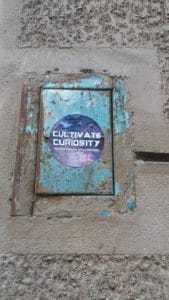
What are you afraid of and how has that fear shaped your life? Fear is a liar and a bully. I’ve walked a road of working through fear. You cannot ignore it, but journey through it to the other side and I know that your life will be far more beautiful and robust when you push through.
Change can be super scary, but staying where you are not always the best option. Become curious about what your life could look like when you try that new business venture or think about the positive outcomes that could take place when you get rid of fear?
Thirdly, try something new.I’ve put this one after conquering fear because trying something new involves curiosity and courage. I saw this sign recently, “Be brave enough to suck at something new.” How amazing is that? What about trying to listen to a different style of music to what you are used to or even watching a different type of movie or read a different genre? Start with little things and watch your life open up.
This week, I’m trying something new. Together, with a group of friends, we are beginning our journey of hiking up the 13 peaks around the Western Cape. We will tackle it over multiple weekends. It’s something new, it’s challenging and I’m hoping it will be fun.
Fourthly, eliminate absolutes from your vocabulary (your inner critic and words you use).I want to encourage you to remove words such as, “never, must, every, or always.” For example, “I will never open my heart again,” or “I always say the wrong thing.” These words are all-encompassing and trap you. So, take care of how you speak to yourself and the words you use in conversations. Be kind and gracious to yourself. If you find yourself using these words, ask yourself what led you to say or think that thought? Replace these absolute words with gentler, more open-hearted words.
What else would you add to this list? I’d love to hear from you.
 PS To celebrate something new and our attempt at climbing 13 peaks, the absolute best socks ever, Balega socks are offering 10% off every purchase using this code: MANDI_HART_10
PS To celebrate something new and our attempt at climbing 13 peaks, the absolute best socks ever, Balega socks are offering 10% off every purchase using this code: MANDI_HART_10
Search for:
 Follow .et_monarch .et_social_shortcode_0 li,.et_monarch .et_social_shortcode_0.et_social_circle ul li i.et_social_icon { background: #7a9d96; } .et_monarch .et_social_shortcode_0.et_social_rounded .et_social_icons_container li:hover, .et_monarch .et_social_shortcode_0.et_social_rectangle .et_social_icons_container li:hover, .et_monarch .et_social_shortcode_0.et_social_circle .et_social_icons_container li:hover i.et_social_icon { background: #dcae1d !important; } .et_monarch .et_social_shortcode_0 .et_social_icon, .et_monarch .et_social_shortcode_0 .et_social_networks .et_social_network_label, .et_monarch .et_social_shortcode_0 .et_social_networkname, .et_monarch .et_social_shortcode_0 .et_social_count { color: #ffffff !important; } .et_monarch .et_social_shortcode_0 .et_social_icons_container li:hover .et_social_icon, .et_monarch .et_social_shortcode_0 .et_social_networks .et_social_icons_container li:hover .et_social_network_label, .et_monarch .et_social_shortcode_0 .et_social_icons_container li:hover .et_social_networkname, .et_monarch .et_social_rounded.et_social_shortcode_0 .et_social_icons_container li:hover .et_social_count, .et_monarch .et_social_rectangle.et_social_shortcode_0 .et_social_icons_container li:hover .et_social_count { color: #ffffff !important; } List of blogs 4 ways to grow curiosity in your life What is fear? 6 parenting skills that can make you more productive at work How to return to activity post Covid-19 Don’t panic, you can conquer fear and Covid-19 Advent in an unprecedented season Fear & anxiety affecting the lives of those you love? How to get your matriculant safely through the exams Healthy habits and how to develop them Ditch mom-guilt today A VUCA world and parenting, what a combo! Intentional parents use these five techniques How to fight compassion fatigue in the time of Covid-19 Five ways to stay the ’emotional tsunami’ from Covid-19. Top 30 ways to keep fit, focused and fearless Courage to dream again is possible. Talking about racial injustice with your children Going back to school? Six essential things to consider. Lamenting, an invitation to honesty Dear COVID 19, we are stronger than you think. Categories Courses FearLess Guest Post Parenting with Courage
Follow .et_monarch .et_social_shortcode_0 li,.et_monarch .et_social_shortcode_0.et_social_circle ul li i.et_social_icon { background: #7a9d96; } .et_monarch .et_social_shortcode_0.et_social_rounded .et_social_icons_container li:hover, .et_monarch .et_social_shortcode_0.et_social_rectangle .et_social_icons_container li:hover, .et_monarch .et_social_shortcode_0.et_social_circle .et_social_icons_container li:hover i.et_social_icon { background: #dcae1d !important; } .et_monarch .et_social_shortcode_0 .et_social_icon, .et_monarch .et_social_shortcode_0 .et_social_networks .et_social_network_label, .et_monarch .et_social_shortcode_0 .et_social_networkname, .et_monarch .et_social_shortcode_0 .et_social_count { color: #ffffff !important; } .et_monarch .et_social_shortcode_0 .et_social_icons_container li:hover .et_social_icon, .et_monarch .et_social_shortcode_0 .et_social_networks .et_social_icons_container li:hover .et_social_network_label, .et_monarch .et_social_shortcode_0 .et_social_icons_container li:hover .et_social_networkname, .et_monarch .et_social_rounded.et_social_shortcode_0 .et_social_icons_container li:hover .et_social_count, .et_monarch .et_social_rectangle.et_social_shortcode_0 .et_social_icons_container li:hover .et_social_count { color: #ffffff !important; } List of blogs 4 ways to grow curiosity in your life What is fear? 6 parenting skills that can make you more productive at work How to return to activity post Covid-19 Don’t panic, you can conquer fear and Covid-19 Advent in an unprecedented season Fear & anxiety affecting the lives of those you love? How to get your matriculant safely through the exams Healthy habits and how to develop them Ditch mom-guilt today A VUCA world and parenting, what a combo! Intentional parents use these five techniques How to fight compassion fatigue in the time of Covid-19 Five ways to stay the ’emotional tsunami’ from Covid-19. Top 30 ways to keep fit, focused and fearless Courage to dream again is possible. Talking about racial injustice with your children Going back to school? Six essential things to consider. Lamenting, an invitation to honesty Dear COVID 19, we are stronger than you think. Categories Courses FearLess Guest Post Parenting with Courage The post 4 ways to grow curiosity in your life appeared first on Mandi Hart.
March 30, 2021
What is fear?
“You gain strength, courage, and confidence by every experience in which you really stop to look fear in the face. You are able to say to yourself, ‘I lived through this horror. I can take the next thing that comes along.’ ” Eleanor Roosevelt
What is fear? Have you thought about it? Google it and you will find countless quotes, and explanations.
Did you know that every person will experience fear in some form during their lifetime, ranging from fear of rejection, fear of pursuing a dream, or even the thought that you cannot be free from its grip? Regardless of who you are or what you want to do, fear will try to trap you. It also has many faces; it never looks the same in two people’s lives.
Fear? Foreign or familiar?

Fear can be a foreign feeling or a familiar sensation that develops when you or someone you love is or feels threatened. It can arise when certain circumstances, conditions or persons cause us to feel intimidated or afraid.
Fear can grow through a real or perceived threat to our sense of well- being. It appears to be genuine to our minds, and thus our bodies respond accordingly. Some natural fears in us are there for our good and self- preservation. It could be the warning in our minds that cautions us against running across a busy road or running outside during a lightning storm.
But there is also a crippling fear that arises because of a valid threat or perceived threat to our sense of safety or well-being. These fears, if not dealt with appropriately, can affect our lives, relationships and life decisions.
Fear can be strategicIt can form a strategy in our minds through reinforcing thought patterns. For example, if fear of failure is an influential factor in my life, then I could have the following thoughts. “If I don’t try something new, then I can’t fail.”
Its strategy is to hinder and restrict one’s thoughts and actions. One such example is a story from an older woman who enjoys nature, but because she is afraid of potential dangers, she doesn’t go outside. By her own admission, she remains locked up in her apartment, alone. She feels despondent and angry but says that she is too scared to even drive to where she wants to go.
Fear likes the words, ‘what if . . .

The paradox of modern fear is that it often isn’t grounded in reality but in our minds. We repeat the mantra of ‘what if . . .’ It would appear that these two words lead our thoughts into a cycle of fear-inducing reactions. For example, what if I went for a run and was attacked by a mugger? What if I fail? What if I don’t make the sports team? To avoid that embarrassment, potential failure or even shame, we end up not even attempting the very thing that could lead us into a full-coloured life and great joy. What is your ‘what if’? How has it robbed you of experiencing the joys of life?
One of the first ports of call for healing comes from naming the battles we face regularly and their impact in our lives and that of our family. Fear likes to live in the shadows. When we emerge out of the darkness and into the light, healing can begin.
Healing from fear takes time. This understanding, along with the fact that fear lies to us, is expressed in an excerpt from a blog post written a mere three months after an armed robbery in my home in Cape Town.
False evidence appearing real (blog post October 2015)I recently had a first-hand experience of false evidence appearing real. Just after the armed robbery, I experienced an irrational fear response. It affected my breathing, with my heart racing, and body shaking from its influence.
Every night, just as we were about to fall asleep and we switched the lights off, I could feel fear wrapping its coils around my mind and after that my body.
Neil would pray for me and talk me back to a place of calmness, but then, a little while later, I would be tormented by this irrational fear. They say fear is ‘False Evidence Appearing Real’. I learned that fear paralyzes you, and it makes you incapable of reasoning. Over time, I realized that fear tries to enslave you, and as I looked around me, I saw many, many people riddled with fear.
These are the effects of fear that I have either experienced or seen manifest around me:
Fear is an illusion. Danger is real, but fear is an illusion that then manifests in different ways in our minds, emotions and bodies.Fear stops you from living, and by that, I mean really living. It inhibits you from taking a risk, from laughing and giving yourself to something or someone.
Fear can make you sick. Lack of sleep suppresses your immune system and your mind’s ability to function at its peak level.
Fear can rule your life and isolate you from those that love you. You shut down and not allow them into specific areas or to support you as you should.
Fear is a liar and feeds your thoughts that you should act too. I guess that’s one of the biggest lies we believe. Many people live as if on a stage, pretending to be ok when deep inside, they are hurting. Let’s start a ‘be real revolution’. It will free you.
Danger and fear are different
Did you know that there is a difference between danger and fear? Sometimes knowing the difference between the two could be a lifesaver.
The Merriam Webster Dictionary defines danger as the possibility that you will be hurt or killed; that something unpleasant or harmful will hap- pen. Danger is a person or thing likely to cause you an injury, pain, harm or loss.
Whereas fear is an unpleasant, often strong emotion caused by anticipation or awareness of danger. The critical difference is that danger is the possibility of injury or harm, and fear is a state of being or an emotion. They are not the same.
It is dangerous to walk on the edge of a cliff or hike during a lightning storm. Or, as a female, walking alone in an isolated area is potentially dangerous. I love running but have to be careful where I run and most of the time make certain that I don’t exercise alone. When you’re in a precarious (dangerous) situation, you can either give in to fear or respond rationally. Fear is often a response to a situation we think we are in, could be in or actually are in at that moment. The danger is real, but giving in to fear is a choice that you make (either consciously or subconsciously).
I realized this shortly after the armed robbery. The danger had passed, but fear still gripped my life. We added extra safety features around our home and were more vigilant. Unfortunately, that didn’t help me. Fear was having a full-on party in my mind; it was busy moving in and setting up shop.
If you’d like to know how I overcame fear, then read about it in my book Courage in the Fire: Overcoming a fear-driven life.
Buy Courage in the Fire now!
Search for: Follow .et_monarch .et_social_shortcode_0 li,.et_monarch .et_social_shortcode_0.et_social_circle ul li i.et_social_icon { background: #7a9d96; } .et_monarch .et_social_shortcode_0.et_social_rounded .et_social_icons_container li:hover, .et_monarch .et_social_shortcode_0.et_social_rectangle .et_social_icons_container li:hover, .et_monarch .et_social_shortcode_0.et_social_circle .et_social_icons_container li:hover i.et_social_icon { background: #dcae1d !important; } .et_monarch .et_social_shortcode_0 .et_social_icon, .et_monarch .et_social_shortcode_0 .et_social_networks .et_social_network_label, .et_monarch .et_social_shortcode_0 .et_social_networkname, .et_monarch .et_social_shortcode_0 .et_social_count { color: #ffffff !important; } .et_monarch .et_social_shortcode_0 .et_social_icons_container li:hover .et_social_icon, .et_monarch .et_social_shortcode_0 .et_social_networks .et_social_icons_container li:hover .et_social_network_label, .et_monarch .et_social_shortcode_0 .et_social_icons_container li:hover .et_social_networkname, .et_monarch .et_social_rounded.et_social_shortcode_0 .et_social_icons_container li:hover .et_social_count, .et_monarch .et_social_rectangle.et_social_shortcode_0 .et_social_icons_container li:hover .et_social_count { color: #ffffff !important; } List of blogs What is fear? 6 parenting skills that can make you more productive at work How to return to activity post Covid-19 Don’t panic, you can conquer fear and Covid-19 Advent in an unprecedented season Fear & anxiety affecting the lives of those you love? How to get your matriculant safely through the exams Healthy habits and how to develop them Ditch mom-guilt today A VUCA world and parenting, what a combo! Intentional parents use these five techniques How to fight compassion fatigue in the time of Covid-19 Five ways to stay the ’emotional tsunami’ from Covid-19. Top 30 ways to keep fit, focused and fearless Courage to dream again is possible. Talking about racial injustice with your children Going back to school? Six essential things to consider. Lamenting, an invitation to honesty Dear COVID 19, we are stronger than you think. Powerful prayers to pray over your sons & daughters Categories Courses FearLess Guest Post Parenting with Courage
Follow .et_monarch .et_social_shortcode_0 li,.et_monarch .et_social_shortcode_0.et_social_circle ul li i.et_social_icon { background: #7a9d96; } .et_monarch .et_social_shortcode_0.et_social_rounded .et_social_icons_container li:hover, .et_monarch .et_social_shortcode_0.et_social_rectangle .et_social_icons_container li:hover, .et_monarch .et_social_shortcode_0.et_social_circle .et_social_icons_container li:hover i.et_social_icon { background: #dcae1d !important; } .et_monarch .et_social_shortcode_0 .et_social_icon, .et_monarch .et_social_shortcode_0 .et_social_networks .et_social_network_label, .et_monarch .et_social_shortcode_0 .et_social_networkname, .et_monarch .et_social_shortcode_0 .et_social_count { color: #ffffff !important; } .et_monarch .et_social_shortcode_0 .et_social_icons_container li:hover .et_social_icon, .et_monarch .et_social_shortcode_0 .et_social_networks .et_social_icons_container li:hover .et_social_network_label, .et_monarch .et_social_shortcode_0 .et_social_icons_container li:hover .et_social_networkname, .et_monarch .et_social_rounded.et_social_shortcode_0 .et_social_icons_container li:hover .et_social_count, .et_monarch .et_social_rectangle.et_social_shortcode_0 .et_social_icons_container li:hover .et_social_count { color: #ffffff !important; } List of blogs What is fear? 6 parenting skills that can make you more productive at work How to return to activity post Covid-19 Don’t panic, you can conquer fear and Covid-19 Advent in an unprecedented season Fear & anxiety affecting the lives of those you love? How to get your matriculant safely through the exams Healthy habits and how to develop them Ditch mom-guilt today A VUCA world and parenting, what a combo! Intentional parents use these five techniques How to fight compassion fatigue in the time of Covid-19 Five ways to stay the ’emotional tsunami’ from Covid-19. Top 30 ways to keep fit, focused and fearless Courage to dream again is possible. Talking about racial injustice with your children Going back to school? Six essential things to consider. Lamenting, an invitation to honesty Dear COVID 19, we are stronger than you think. Powerful prayers to pray over your sons & daughters Categories Courses FearLess Guest Post Parenting with Courage The post What is fear? appeared first on Mandi Hart.
March 4, 2021
6 parenting skills that can make you more productive at work
Often parents come to me for support when things go pear-shaped in the home. If you mention parenting and work in the same sentence, then rolling of eyeballs and big sighs often take place.
But did you know that the skills you learn in parenting can help you in the marketplace? And, if you strengthen your parenting ability, it will help you become more confident and productive at work?
The skills at work and in the home can actually be transferable. You don’t have to have a family crisis to decide to join a parenting course or read a parenting book.
As I wrote this post, I reflected on our day. I had to find a quiet space for a Zoom meeting (and the only one ended up being at my daughter’s desk). My husband also had his fair share of Zoom meetings today with me hearing dog’s barking in the background of one of them. In many homes, finding meeting places away from energetic toddlers, homeschooling children and normal home activities is sometimes a challenge.
What are these 6 skills that can help you be more productive at work?Time management
Managing the schedules of busy children is no small feat. In my parenting course, I have a session on self-care. Most moms almost burst into tears at the mention of that word. But by the end of the lesson, we’ve discussed how to manage time to take care of your family and yourself too. It is possible. Not easy, but possible.
Covid came out of the blue, and working from home was (and still is for now) a reality. Time management skills highly apply now more than ever. With so many dynamics at play, this coupled with project management is vital.
Staying positive when chaos reignsMany times when I chat with parents, they speak about the chaos in their homes. Kid’s toys all over the place, sibling rivalry that wears them down, and children that backchat.
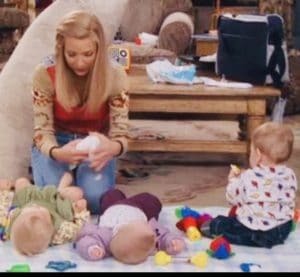 Recently, we watched an episode of Friends. The one where Phoebe ends up taking care of the triplets. When Monica & Chandler return home, curtains have been ripped, and the place is trashed. But Phoebe repeats several times, “I took care of the triplets all by myself, and now they are sleeping.” I laughed because, honestly, that’s what it felt like when my children were toddlers. It was chaotic.
Recently, we watched an episode of Friends. The one where Phoebe ends up taking care of the triplets. When Monica & Chandler return home, curtains have been ripped, and the place is trashed. But Phoebe repeats several times, “I took care of the triplets all by myself, and now they are sleeping.” I laughed because, honestly, that’s what it felt like when my children were toddlers. It was chaotic.
But learning to adapt when things feel as if they are falling apart is so important at work. Sometimes results are slow in coming, but they are worth it in the end.
Adapting to remain agileParenting is the most adventurous challenge in the world. We have to keep on adapting while remaining agile. This skill is super important in the marketplace. The keyword in both environments is ‘adapt’. In volatile markets (and sometimes homes) and an ever-changing environment, agility keeps you grounded and moving forward. Learning to adapt at home and at work builds resilience.
Learning new skills boosts dopamine levelsWhen you learn new skills and adapt your parenting styles as your children grow, it boosts the reward centre in your brain and positivity increases. These new skills help with the development of a growth mindset. I think we should always keep on learning. What new skills did you learn over the past year?
Communication techniques evolve as your kids growThink about how you communicate with your children as they grow from toddlers to young adults. We sent videos, text messages, obviously loads of face time but also written notes and more. Learning to communicate well is vital to success at work. When your children become teens, your skill at drawing unwilling information out is crucial. The ability to ask questions that open up what’s going on builds your relationship at home. Transfer this to the marketplace and you will find your influence grows.
EQ and other softer skillsLearning fresh parenting skills is certainly not about the bottom line. But applying emotional intelligence at work, and other life skills that you use at home is a good thing.
In a Forbes article, Josh Turner, wrote, “EQ allows people to tap into their audiences and deliver consistent branding and content. In most cases, marketers think using emotional intelligence means eliciting an emotional response or tackling a critical pain point. The truth is, EQ is much more than that.” He concludes with, “Finally, emotional intelligence can play a significant role in how you identify and learn from your mistakes.”
Isn’t that amazing?
And here, we all thought that parenting was just parenting. In other words, if you boost your parenting skills at home, they can translate into productivity at work.
I empower parents to grow their parenting skills.
Why don’t you sign up for the next course? Click here to find out more.
Search for: Follow .et_monarch .et_social_shortcode_0 li,.et_monarch .et_social_shortcode_0.et_social_circle ul li i.et_social_icon { background: #7a9d96; } .et_monarch .et_social_shortcode_0.et_social_rounded .et_social_icons_container li:hover, .et_monarch .et_social_shortcode_0.et_social_rectangle .et_social_icons_container li:hover, .et_monarch .et_social_shortcode_0.et_social_circle .et_social_icons_container li:hover i.et_social_icon { background: #dcae1d !important; } .et_monarch .et_social_shortcode_0 .et_social_icon, .et_monarch .et_social_shortcode_0 .et_social_networks .et_social_network_label, .et_monarch .et_social_shortcode_0 .et_social_networkname, .et_monarch .et_social_shortcode_0 .et_social_count { color: #ffffff !important; } .et_monarch .et_social_shortcode_0 .et_social_icons_container li:hover .et_social_icon, .et_monarch .et_social_shortcode_0 .et_social_networks .et_social_icons_container li:hover .et_social_network_label, .et_monarch .et_social_shortcode_0 .et_social_icons_container li:hover .et_social_networkname, .et_monarch .et_social_rounded.et_social_shortcode_0 .et_social_icons_container li:hover .et_social_count, .et_monarch .et_social_rectangle.et_social_shortcode_0 .et_social_icons_container li:hover .et_social_count { color: #ffffff !important; } List of blogs 6 parenting skills that can make you more productive at work How to return to activity post Covid-19 Don’t panic, you can conquer fear and Covid-19 Advent in an unprecedented season Fear & anxiety affecting the lives of those you love? How to get your matriculant safely through the exams Healthy habits and how to develop them Ditch mom-guilt today A VUCA world and parenting, what a combo! Intentional parents use these five techniques How to fight compassion fatigue in the time of Covid-19 Five ways to stay the ’emotional tsunami’ from Covid-19. Top 30 ways to keep fit, focused and fearless Courage to dream again is possible. Talking about racial injustice with your children Going back to school? Six essential things to consider. Lamenting, an invitation to honesty Dear COVID 19, we are stronger than you think. Powerful prayers to pray over your sons & daughters Adapt to survive and thrive after setbacks Categories Courses FearLess Guest Post Parenting with Courage
Follow .et_monarch .et_social_shortcode_0 li,.et_monarch .et_social_shortcode_0.et_social_circle ul li i.et_social_icon { background: #7a9d96; } .et_monarch .et_social_shortcode_0.et_social_rounded .et_social_icons_container li:hover, .et_monarch .et_social_shortcode_0.et_social_rectangle .et_social_icons_container li:hover, .et_monarch .et_social_shortcode_0.et_social_circle .et_social_icons_container li:hover i.et_social_icon { background: #dcae1d !important; } .et_monarch .et_social_shortcode_0 .et_social_icon, .et_monarch .et_social_shortcode_0 .et_social_networks .et_social_network_label, .et_monarch .et_social_shortcode_0 .et_social_networkname, .et_monarch .et_social_shortcode_0 .et_social_count { color: #ffffff !important; } .et_monarch .et_social_shortcode_0 .et_social_icons_container li:hover .et_social_icon, .et_monarch .et_social_shortcode_0 .et_social_networks .et_social_icons_container li:hover .et_social_network_label, .et_monarch .et_social_shortcode_0 .et_social_icons_container li:hover .et_social_networkname, .et_monarch .et_social_rounded.et_social_shortcode_0 .et_social_icons_container li:hover .et_social_count, .et_monarch .et_social_rectangle.et_social_shortcode_0 .et_social_icons_container li:hover .et_social_count { color: #ffffff !important; } List of blogs 6 parenting skills that can make you more productive at work How to return to activity post Covid-19 Don’t panic, you can conquer fear and Covid-19 Advent in an unprecedented season Fear & anxiety affecting the lives of those you love? How to get your matriculant safely through the exams Healthy habits and how to develop them Ditch mom-guilt today A VUCA world and parenting, what a combo! Intentional parents use these five techniques How to fight compassion fatigue in the time of Covid-19 Five ways to stay the ’emotional tsunami’ from Covid-19. Top 30 ways to keep fit, focused and fearless Courage to dream again is possible. Talking about racial injustice with your children Going back to school? Six essential things to consider. Lamenting, an invitation to honesty Dear COVID 19, we are stronger than you think. Powerful prayers to pray over your sons & daughters Adapt to survive and thrive after setbacks Categories Courses FearLess Guest Post Parenting with Courage The post 6 parenting skills that can make you more productive at work appeared first on Mandi Hart.
February 10, 2021
How to return to activity post Covid-19
In life, take small steps to get moving in the right direction. The thing is to not stop, no matter how slow it may feel.
Our lives are shaped by a pandemic in more ways than we could ever have imagined. So, what does recovery and return to activity look like post-Covid? Seriously, what does that even look like? My husband, Neil, and I had Covid over December 2020 and into the new year, and now Neil has it for the second time! This virus is unpredictable, and it got me thinking…what does a healthy return to activity look like?
Many of you know I enjoy running. It’s my happy space, my therapy-space, my thinking and prayer space, and I really enjoy it! Whether I run alone, with my trusty Ridgeback Nola, or with family and friends, running is always a joy.
Return to activity is slower than we all expected

And so, to my horror, I discovered that COVID-19 affects many aspects of one’s body, primarily it seems to affect the heart. When attempting to return to exercise, I discovered that my heart rate spiked after 300m of slow jogging. Weird right? But I wasn’t alone. Athletes have posted similar responses, from seasoned runners and cyclist to those who enjoy an active lifestyle.
Taking to social media, Zola Budd said she and her daughter had both recently been diagnosed with Covid. Fortunately, both came through the illness without any severe symptoms but that was not the end of their coronavirus experience.
“It has been four weeks now since our positive test and three weeks since I experienced any symptoms,” she wrote. “I decided to start training again and am experiencing the following symptoms: elevated heart rate. My heart rate, even doing easy runs of not more than 30 minutes is about 20 beats per minute faster than normal.
“Usually, after an easy run, it takes about 1 minute for my HR to go below 120bpm. Now, it takes almost four minutes. This shows me that even after three weeks of no symptoms, my heart is still under strain,” she concluded.
Go slower than you expect. If you are tired and listless or notice an unusually elevated heart rate when you exercise, the best place to advance your return to activity may be on the couch (or if need be, see your doctor). But, the message is clear. Take it slow.
In an article on Returning to Exercise after. recovering from COVID-19, Dr Jordan Metzl says that there’s a caveat now with the pandemic. “If you had COVID-19 and experienced any of these symptoms, that really flips the script on you, and you have to be much more careful about how you go back to activity. As sports medicine doctors, we want all of our patients to get out there and move, but this is one of the few times in our career where I’m really having to tell people to pump the breaks and pursue really gentle activity,”
Again, the message from Dr Metzl is this: “I want to make sure they have a very slow, gradual resumption of activity.”
And so, for those who want to know how to recover, I thought I’d share some tips. Please bear in mind that I love being active, but am not a doctor. If you are worried about any of your symptoms, please seek medical help.
What you need to know (and possibly never thought about before)In an insightful article on Women’s Running, Dr. Kim notes, “According to the CDC, scientists have learned “that many organs besides the lungs are affected by COVID-19 and there are many ways the infection can affect someone’s health.” In particular, they are watching how the virus interacts and causes damage to the heart. The inflammation and damage they are worried about is called myocarditis.”
The article goes on to report, “To avoid putting stress on the heart before it’s ready, runners shouldn’t plan to pick up where they left off in their training. In the guidelines for competitive and highly active recreational athletes from the ACC, I recommend a minimum of 10 days of full recovery with a slow return to activity and evaluation by a medical professional if your symptoms are moderate or lingering.”
You know your body best, listen to what it is telling you
“If you have a body system that’s been infected, it’s important to gradually tax that system to see where you are,” says Dr. Metzl. This makes such sense. Gradual is the key. Now if you’re prone to an all-or-nothing attitude, then this is going to be difficult. But it is super important.
Take care of yourself by treating yourself like you would your best friend. Be considerate, kind, and extra gentle. Gentle on your expectations, gentle on your body and gentle on your life rhythms.
You cannot just start where you stopped before COVID-19. In fact, this applies to flu or other serious illnesses too. Take a calculated approach to your return to activity.
Keep on taking those supplements
It’s so easy to stop taking your supplements when you feel better. But, don’t stop. I’ll be transparent here. This is is what we’ve been taking: Vitamin C, Zinc, Vitamin B, Omegas, some aspirin and probiotics. We’ve also bought a Herbalife Shake for when our energy levels drop in the middle of the day. And I am still diffusing the dōTERRA oils in my home. We also continue to take Life Matrix MCT Oil (they dub it ‘super fuel’ for your cells and it helps decrease cardiovascular disease). We are still following our doctor’s recommendations.
Omegas, some aspirin and probiotics. We’ve also bought a Herbalife Shake for when our energy levels drop in the middle of the day. And I am still diffusing the dōTERRA oils in my home. We also continue to take Life Matrix MCT Oil (they dub it ‘super fuel’ for your cells and it helps decrease cardiovascular disease). We are still following our doctor’s recommendations.
Our family is also paying attention to what we eat. Our vegetable garden has started producing some wonderful veggies and we make sure that we get loads of good nutrients in through our diet.
Have a sober, calculated approach to exercise
Be aware of your resting heart rate and blood pressure levels. If your resting heart rate is elevated, then don’t exercise. Consider your approach to return to exercise. Depending on your COVID-19 symptoms, and if you need to consult your doctor, take it slower than you normally would.
This is my plan…slow and steady. I started with Pilates, a gentle surf and a very, very slow run/walk of 4km (I kept my heart rate below 140 bpm). I found that when I started running, my heart rate would jump up to over 180bpm and so I would walk and focus on my breathing to get it down.
Take note of how long it takes for your heart rate to come down and your energy levels after exercise. Friends, I was running up to 21km just before I got COVID-19 and it’s hard to take it slow, but I believe it is so very necessary. This all comes with a mindset shift. When you adjust your thought processes, then your words and actions follow.
Rest when you need to rest
Fortunately, my working hours are flexible, but I still find that I need to rest around 2 pm for 20 minutes or so. If you feel you need to rest, do it. Sleep brings healing to one’s body and mind. Seriously friends, don’t underestimate the power of sleep in your life. It builds resilience and is like a golden chain that ties health and our bodies together.
Sometimes, we need to go slow so we can go long. And like Terri Guillemets said: ”A day without a nap is like a cupcake without frosting.”
Pay attention to your symptoms. Stop exercising if they return.
Don’t fool around, friends. If you develop symptoms after exercising, including chest pain, fever, palpitations or shortness of breath, see a doctor.
Cultivate joy and thankfulness
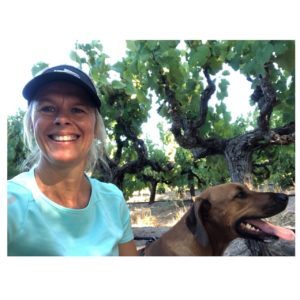
Every time you move, do some activity and find yourself smiling, be thankful. This year, I’m part of the global team as a Balega Impi Ambassador. Impi is a Zulu word that means warrior. A few years back, I struggled with blisters when I went running and then I discovered Balega socks. What a difference…why do I share this? Well, every time I don a pair of these socks, I smile. My feet feel hugged and best of all, I haven’t had one blister since I bought my first pair of Balegas.
It’s sometimes the small things that bring us joy. Be it a cup of coffee, a hug from someone you love, a cool pair of socks or affection from your dog. There is so much to be thankful for. Life is a gift to treasure.
I’d love to hear from you. What would you add to my tips on returning to activity after COVID-19?
Search for:
 Follow .et_monarch .et_social_shortcode_0 li,.et_monarch .et_social_shortcode_0.et_social_circle ul li i.et_social_icon { background: #7a9d96; } .et_monarch .et_social_shortcode_0.et_social_rounded .et_social_icons_container li:hover, .et_monarch .et_social_shortcode_0.et_social_rectangle .et_social_icons_container li:hover, .et_monarch .et_social_shortcode_0.et_social_circle .et_social_icons_container li:hover i.et_social_icon { background: #dcae1d !important; } .et_monarch .et_social_shortcode_0 .et_social_icon, .et_monarch .et_social_shortcode_0 .et_social_networks .et_social_network_label, .et_monarch .et_social_shortcode_0 .et_social_networkname, .et_monarch .et_social_shortcode_0 .et_social_count { color: #ffffff !important; } .et_monarch .et_social_shortcode_0 .et_social_icons_container li:hover .et_social_icon, .et_monarch .et_social_shortcode_0 .et_social_networks .et_social_icons_container li:hover .et_social_network_label, .et_monarch .et_social_shortcode_0 .et_social_icons_container li:hover .et_social_networkname, .et_monarch .et_social_rounded.et_social_shortcode_0 .et_social_icons_container li:hover .et_social_count, .et_monarch .et_social_rectangle.et_social_shortcode_0 .et_social_icons_container li:hover .et_social_count { color: #ffffff !important; } List of blogs How to return to activity post Covid-19 Don’t panic, you can conquer fear and Covid-19 Advent in an unprecedented season Fear & anxiety affecting the lives of those you love? How to get your matriculant safely through the exams Healthy habits and how to develop them Ditch mom-guilt today A VUCA world and parenting, what a combo! Intentional parents use these five techniques How to fight compassion fatigue in the time of Covid-19 Five ways to stay the ’emotional tsunami’ from Covid-19. Top 30 ways to keep fit, focused and fearless Courage to dream again is possible. Talking about racial injustice with your children Going back to school? Six essential things to consider. Lamenting, an invitation to honesty Dear COVID 19, we are stronger than you think. Powerful prayers to pray over your sons & daughters Adapt to survive and thrive after setbacks Duncan Stewart – a man after creativity Categories Courses FearLess Guest Post Parenting with Courage
Follow .et_monarch .et_social_shortcode_0 li,.et_monarch .et_social_shortcode_0.et_social_circle ul li i.et_social_icon { background: #7a9d96; } .et_monarch .et_social_shortcode_0.et_social_rounded .et_social_icons_container li:hover, .et_monarch .et_social_shortcode_0.et_social_rectangle .et_social_icons_container li:hover, .et_monarch .et_social_shortcode_0.et_social_circle .et_social_icons_container li:hover i.et_social_icon { background: #dcae1d !important; } .et_monarch .et_social_shortcode_0 .et_social_icon, .et_monarch .et_social_shortcode_0 .et_social_networks .et_social_network_label, .et_monarch .et_social_shortcode_0 .et_social_networkname, .et_monarch .et_social_shortcode_0 .et_social_count { color: #ffffff !important; } .et_monarch .et_social_shortcode_0 .et_social_icons_container li:hover .et_social_icon, .et_monarch .et_social_shortcode_0 .et_social_networks .et_social_icons_container li:hover .et_social_network_label, .et_monarch .et_social_shortcode_0 .et_social_icons_container li:hover .et_social_networkname, .et_monarch .et_social_rounded.et_social_shortcode_0 .et_social_icons_container li:hover .et_social_count, .et_monarch .et_social_rectangle.et_social_shortcode_0 .et_social_icons_container li:hover .et_social_count { color: #ffffff !important; } List of blogs How to return to activity post Covid-19 Don’t panic, you can conquer fear and Covid-19 Advent in an unprecedented season Fear & anxiety affecting the lives of those you love? How to get your matriculant safely through the exams Healthy habits and how to develop them Ditch mom-guilt today A VUCA world and parenting, what a combo! Intentional parents use these five techniques How to fight compassion fatigue in the time of Covid-19 Five ways to stay the ’emotional tsunami’ from Covid-19. Top 30 ways to keep fit, focused and fearless Courage to dream again is possible. Talking about racial injustice with your children Going back to school? Six essential things to consider. Lamenting, an invitation to honesty Dear COVID 19, we are stronger than you think. Powerful prayers to pray over your sons & daughters Adapt to survive and thrive after setbacks Duncan Stewart – a man after creativity Categories Courses FearLess Guest Post Parenting with Courage The post How to return to activity post Covid-19 appeared first on Mandi Hart.


